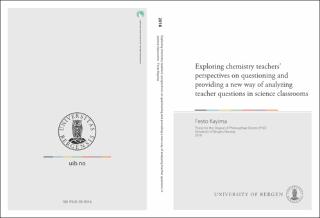| dc.description.abstract | The goals of this dissertation were, to examine how chemistry teachers conceptualize the nature of questions used in teaching, as well as how their understanding influences their questioning practice, and to explore a new way of studying and evaluating teachers’ questions within the contexts in which the questions occur. The overall research work is reported in three papers which form this dissertation. Paper I explores how chemistry teachers construe the practice of questioning and the nature of questions they use in their own teaching, and how the teachers have developed their knowledge about questioning. The aims in paper I were achieved by analyzing semi-structured interviews of eleven secondary chemistry teachers from the city of Bergen in Norway. The analysis and interpretation process was informed by Gadamer’s philosophical hermeneutics (Gadamer, 2004). The results reveal that the teachers hold a dichotomous system of question types that they apply in whole-class situations. This system is simpler than most of the question classification systems used in research, and the two types, “facts”-questions and “thinking”-questions, are used flexibly in different situations for different purposes. By facts-questions teachers implied questions that request students for information that they (students) had learnt from before, whereas by thinking-questions, the teachers implied a kind of questions that ask students for their experiences (thinking, opinions or views) about a chemical phenomenon under consideration. From paper I analysis results, conflicting purposes with asking a question seem to be an important reason for why teachers ask many facts questions. The wish for communicating with their students during the lesson wins over the initiation of students’ thinking. In paper II, five out of 41 question classification taxonomies developed by different educational researchers since 1956 are analyzed. The taxonomies were developed either for use in research as systematic observation instruments, or for classroom teaching purposes. The aim of the analysis was to examine the extent to which the taxonomies could be used by chemistry teachers as a guide to formulating and using questions as desired to achieve target objectives. The conclusions were that the taxonomies were complex and seemed inconsistent with how teachers think about questioning as established in paper I. As a result, in paper II, an alternative framework is proposed as a guide to teachers for developing and using classroom questions. Paper III suggests an alternative methodological approach that could be used in the study and evaluation of teachers’ questions based on their situational adequacy. The development process follows a review of relevant methodological approaches and frameworks for analyzing teacher discourse, along with a review of how teacher questions have been conceptualized by researchers from both the process-product and sociolinguistic (interpretive) paradigms. The resulting product is a three-step methodological approach for studying and evaluating teacher questions. It comprises three theoretical frameworks, each employed in one of the three analysis steps. The first step uses the Identification, Interpretation—Evaluation, Response (IIER) framework by Louca, Zacharia, and Tzialli (2012) to characterize the context of questions, the second step consist of a designed protocol to evaluate the questions’ adequacy, and the third step utilizes a classification scheme by Anderson et al. (2001) to determine the cognitive level of questions. Results from applying the approach to teachers’ questions in eight science lessons from the 1999 TIMSS-video study indicate that the approach offers a meaningful way of studying and evaluating teacher questions that opens up for new perspectives regarding, the nature of classroom aspects addressed by a teacher’s questions, the moment by moment distribution of questions along different classroom aspects (content of questions), how students’ reactions and needs influence the teachers’ use of certain questions, and the overall value of teacher questions in a given teaching context. | en_US |
